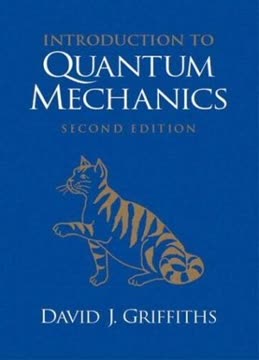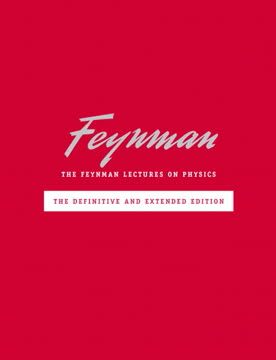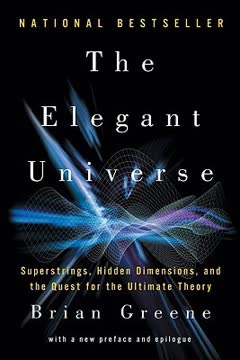Key Takeaways
1. Quantum Mechanics: A Probabilistic World
gives the probability of finding the particle at point x, at time t—or, more precisely.
Statistical Interpretation. Quantum mechanics fundamentally departs from classical mechanics by embracing probability. The wave function, Ψ, doesn't pinpoint a particle's location but instead describes the likelihood of finding it at a particular point in space and time. This probabilistic nature introduces an inherent uncertainty into the quantum world, challenging our classical intuitions about determinacy.
Born's Rule. The absolute square of the wave function, |Ψ|^2, represents the probability density. This means the probability of finding a particle within a small region is proportional to the value of |Ψ|^2 in that region. This interpretation highlights that quantum mechanics deals with statistical predictions rather than definite outcomes.
Measurement Problem. The act of measurement dramatically alters the wave function, causing it to "collapse" into a specific state. This collapse introduces a discontinuous change, distinct from the smooth evolution governed by the Schrödinger equation. The role of measurement and the nature of wave function collapse remain central topics of debate in quantum mechanics.
2. The Schrödinger Equation: Quantum's Guiding Law
The Schrödinger equation plays a role logically analogous to Newton’s second law: Given suitable initial conditions (typically, ), the Schrödinger equation determines for all future time, just as, in classical mechanics, Newton’s law determines for all future time.
Analog to Newton's Law. The Schrödinger equation is the cornerstone of quantum mechanics, dictating how the wave function of a particle evolves over time. Just as Newton's second law governs the motion of classical objects, the Schrödinger equation governs the behavior of quantum systems.
Time-Dependent and Time-Independent Forms. The Schrödinger equation comes in two primary forms: the time-dependent equation, which describes the evolution of a system over time, and the time-independent equation, which applies to stationary states with constant energy. Solving these equations provides the wave function, the key to understanding a quantum system.
Solving for the Wave Function. The solutions to the Schrödinger equation, the wave functions, are complex-valued functions that encode the quantum state of a particle. These solutions are subject to specific boundary conditions, which depend on the potential energy function and the physical constraints of the system.
3. Operators and Expectation Values: Extracting Meaning
To calculate the expectation value of any such quantity, , we simply replace every p by , insert the resulting operator between and , and integrate.
Operators Represent Observables. In quantum mechanics, physical quantities like position, momentum, and energy are represented by mathematical operators. These operators act on wave functions to extract information about the corresponding observable.
Expectation Values. The expectation value of an observable is the average result of measuring that quantity on a large number of identically prepared systems. It is calculated by "sandwiching" the corresponding operator between the wave function and its complex conjugate, then integrating over all space.
Dynamical Variables. All classical dynamical variables can be expressed in terms of position and momentum. To calculate the expectation value of any such quantity, , we simply replace every p by , insert the resulting operator between and , and integrate.
4. Uncertainty Principle: The Limits of Knowledge
Thus a spread in wavelength corresponds to a spread in momentum, and our general observation now says that the more precisely determined a particle’s position is, the less precisely is its momentum.
Fundamental Limit. The Heisenberg uncertainty principle is a cornerstone of quantum mechanics, setting a fundamental limit on the precision with which certain pairs of physical quantities can be known simultaneously. The more accurately we know a particle's position, the less accurately we can know its momentum, and vice versa.
Mathematical Formulation. Mathematically, the uncertainty principle is expressed as ΔxΔp ≥ ħ/2, where Δx and Δp are the standard deviations of position and momentum, respectively, and ħ is the reduced Planck constant. This inequality implies that there is an inherent trade-off between the precision of these two measurements.
Wave Nature of Particles. The uncertainty principle arises from the wave nature of particles. Just as a wave with a well-defined wavelength has an ill-defined position, a particle with a well-defined momentum has an ill-defined position. This wave-particle duality is at the heart of quantum mechanics.
5. Time-Independent Potentials: Unveiling Stationary States
Every expectation value is constant in time; we might as well drop the factor altogether, and simply use in place of .
Separation of Variables. When the potential energy is independent of time, the Schrödinger equation can be solved using separation of variables. This leads to solutions of the form Ψ(x,t) = ψ(x)f(t), where ψ(x) is a spatial wave function and f(t) is a time-dependent factor.
Stationary States. These separable solutions represent stationary states, meaning that the probability density |Ψ(x,t)|^2 is constant in time. In stationary states, the particle's energy is well-defined, and all expectation values remain constant.
Linear Combinations. The general solution to the time-dependent Schrödinger equation is a linear combination of stationary states, each with its characteristic time dependence. This allows for the construction of wave functions that evolve in time, exhibiting phenomena like interference and wave packet propagation.
6. Symmetry and Conservation: The Quantum Dance
Symmetries imply conservation laws.
Transformations and Invariance. A symmetry exists when a transformation leaves the system unchanged. In quantum mechanics, this means the Hamiltonian remains invariant under the transformation. Examples include translational symmetry, rotational symmetry, and parity (spatial inversion).
Conservation Laws. Symmetries are intimately connected to conservation laws. If a Hamiltonian possesses a certain symmetry, then the corresponding physical quantity is conserved. For example, translational symmetry implies conservation of momentum, rotational symmetry implies conservation of angular momentum, and time-translation invariance implies conservation of energy.
Degeneracy. Symmetries often lead to degeneracy in the energy spectrum. If a Hamiltonian commutes with a symmetry operator, then the eigenstates of the Hamiltonian can be chosen to also be eigenstates of the symmetry operator. When multiple states share the same energy, the system is said to be degenerate.
7. Approximation Techniques: Navigating Complexity
This is the fundamental result of first-order perturbation theory; as a practical matter, it may well be the most frequently used equation in quantum mechanics.
Perturbation Theory. Perturbation theory is a powerful tool for approximating solutions to the Schrödinger equation when the potential is only slightly different from a solvable one. It involves expressing the Hamiltonian as a sum of an unperturbed part and a small perturbation, then finding corrections to the energy eigenvalues and eigenfunctions.
Variational Principle. The variational principle provides a method for estimating the ground state energy of a quantum system, even when the Schrödinger equation cannot be solved exactly. It states that the expectation value of the Hamiltonian in any trial state will always be greater than or equal to the true ground state energy.
WKB Approximation. The Wentzel-Kramers-Brillouin (WKB) approximation is a semi-classical method for finding approximate solutions to the Schrödinger equation in one dimension. It is particularly useful for calculating bound state energies and tunneling rates through potential barriers.
8. Scattering Theory: Particles in Collision
Evidently the differential cross-section (which is the quantity of interest to the experimentalist) is equal to the absolute square of the scattering amplitude (which is obtained by solving the Schrödinger equation).
Scattering Amplitude. Quantum scattering theory describes the behavior of particles as they interact with a potential. The scattering amplitude, f(θ), quantifies the probability of a particle being scattered into a particular direction θ.
Differential Cross-Section. The differential cross-section, dσ/dΩ, is a measure of the probability of scattering into a particular solid angle dΩ. It is directly related to the scattering amplitude by the equation dσ/dΩ = |f(θ)|^2.
Born Approximation. The Born approximation is a method for calculating the scattering amplitude when the potential is weak. It involves approximating the wave function as a plane wave and then calculating the scattering amplitude using perturbation theory.
9. Identical Particles: Exchange and Exclusion
We call it an exchange force, although it’s not really a force at all—no physical agency is pushing on the particles; rather, it is a purely geometrical consequence of the symmetrization requirement.
Bosons and Fermions. In quantum mechanics, identical particles are fundamentally indistinguishable. This leads to the symmetrization principle, which states that the wave function of a system of identical particles must be either symmetric (for bosons) or antisymmetric (for fermions) under the exchange of any two particles.
Pauli Exclusion Principle. The Pauli exclusion principle is a direct consequence of the antisymmetry requirement for fermions. It states that no two identical fermions can occupy the same quantum state simultaneously. This principle is crucial for understanding the structure of atoms, the behavior of electrons in solids, and the stability of matter.
Exchange Forces. The symmetrization requirement leads to effective "exchange forces" between identical particles. Identical bosons tend to be closer together than distinguishable particles, while identical fermions tend to be farther apart. These exchange forces are purely quantum mechanical and have no classical analog.
10. Measurement Problem: Observer's Role
Observations not only disturb what is to be measured, they produce it …We compel [the particle] to assume a definite position.
Realist, Orthodox, and Agnostic Positions. The measurement problem in quantum mechanics arises from the statistical interpretation of the wave function. It questions whether particles have definite properties prior to measurement (realist position), whether the act of measurement creates these properties (orthodox position), or whether such questions are meaningless (agnostic position).
Collapse of the Wave Function. The orthodox interpretation posits that the act of measurement causes the wave function to collapse into a specific eigenstate of the measured observable. This collapse is instantaneous and discontinuous, raising questions about the nature of measurement and the role of the observer.
EPR Paradox and Bell's Theorem. The EPR paradox and Bell's theorem challenge the realist position by demonstrating that quantum mechanics predicts correlations between distant particles that cannot be explained by local hidden variable theories. Experiments have confirmed these correlations, suggesting that nature itself is fundamentally nonlocal.
Last updated:
FAQ
1. What is Introduction to Quantum Mechanics by David J. Griffiths about?
- Comprehensive undergraduate introduction: The book provides a thorough introduction to quantum mechanics for junior and senior undergraduates, focusing on both foundational concepts and practical calculation techniques.
- Emphasis on doing quantum mechanics: Griffiths prioritizes teaching students how to perform quantum calculations, postponing philosophical discussions until later chapters.
- Structured for flexibility: The text is divided into two main parts—basic theory and approximation methods/applications—allowing instructors and students to tailor their study path.
- Bridges classical and quantum ideas: The book frequently relates quantum concepts to classical analogs, aiding conceptual understanding.
2. Why should I read Introduction to Quantum Mechanics by David J. Griffiths?
- Clear and accessible explanations: Griffiths is renowned for his lucid writing style, making complex quantum concepts approachable for students with the necessary mathematical background.
- Strong mathematical foundation: The book carefully develops the mathematical formalism of quantum mechanics, including Hilbert spaces, operators, and eigenvalues.
- Practical problem-solving focus: Emphasis is placed on solving real quantum problems, with numerous worked examples and exercises.
- Widely adopted and respected: It is a standard text in many undergraduate physics programs, valued for its balance of rigor and intuition.
3. What are the key takeaways from Introduction to Quantum Mechanics by David J. Griffiths?
- Wave function as central object: The wave function encodes all measurable information about a quantum system, with its squared magnitude giving probability densities.
- Quantum indeterminacy and measurement: Quantum mechanics fundamentally predicts probabilities, not certainties, and measurement collapses the wave function to a definite outcome.
- Operator formalism and observables: Physical quantities correspond to hermitian operators, with eigenvalues representing possible measurement results.
- Approximation methods are essential: Techniques like perturbation theory and the variational principle are crucial for tackling real-world systems where exact solutions are unavailable.
4. What is the main teaching approach and structure of Introduction to Quantum Mechanics by David J. Griffiths?
- Step-by-step development: The book introduces basic postulates and mathematical tools before moving to more advanced topics and applications.
- Two-part organization: Part I covers foundational theory, while Part II addresses approximation methods and practical applications, allowing flexible course design.
- Emphasis on calculation: Griffiths encourages students to learn by doing, with a focus on explicit calculations and problem-solving.
- Delayed philosophical discussion: Deeper interpretational issues are addressed in the afterword, keeping the main text focused on practical mastery.
5. How does Introduction to Quantum Mechanics by David J. Griffiths explain the wave function and its interpretation?
- Probability amplitude concept: The wave function ψ(x,t) is a complex-valued function whose squared magnitude gives the probability density for finding a particle at a given position and time.
- Born’s statistical interpretation: Even with complete knowledge of ψ, only statistical predictions for measurement outcomes are possible, reflecting inherent quantum indeterminacy.
- Wave function collapse: Measurement causes the wave function to collapse to an eigenstate corresponding to the observed value, a process distinct from the continuous evolution described by the Schrödinger equation.
- Role in measurement: The probability of obtaining a particular measurement result is given by the squared projection of the state onto the relevant eigenfunction.
6. What is the significance of the Schrödinger equation in Introduction to Quantum Mechanics by David J. Griffiths?
- Central dynamical law: The Schrödinger equation governs the time evolution of the wave function, analogous to Newton’s laws in classical mechanics.
- Time-dependent and time-independent forms: The book distinguishes between the full time-dependent equation for general evolution and the time-independent equation for stationary states.
- Separation of variables: Solutions can often be separated into spatial and temporal parts, leading to stationary states with definite energies.
- Foundation for quantum systems: The equation is the starting point for analyzing all quantum systems discussed in the book.
7. How does Introduction to Quantum Mechanics by David J. Griffiths address the uncertainty principle?
- Wave nature of particles: The uncertainty principle arises from the wave-like properties of quantum objects, relating the spreads in position and momentum.
- Quantitative formulation: The book presents the standard inequality σ_x σ_p ≥ ħ/2 and generalizes it to any pair of non-commuting observables.
- Minimum-uncertainty states: Gaussian wave packets are shown to minimize the uncertainty product, representing the most localized states allowed by quantum mechanics.
- Implications for measurement: The principle sets fundamental limits on the precision of simultaneous measurements of certain pairs of observables.
8. What are the key quantum systems and potentials analyzed in Introduction to Quantum Mechanics by David J. Griffiths?
- Infinite and finite square wells: These models illustrate quantization of energy and the emergence of discrete stationary states.
- Harmonic oscillator: Treated both analytically and algebraically, it demonstrates ladder operators and equally spaced energy levels.
- Hydrogen atom: The book solves the hydrogen atom using spherical coordinates, revealing quantized energy levels and angular momentum.
- Free particle and delta-function potential: These cases introduce continuous spectra, tunneling, and the concept of bound versus scattering states.
9. How does Introduction to Quantum Mechanics by David J. Griffiths explain angular momentum and spin?
- Operator formalism: Angular momentum components are represented by operators with specific commutation relations, leading to quantization.
- Spherical harmonics: The angular part of wave functions are spherical harmonics, which are eigenfunctions of angular momentum operators.
- Spin as intrinsic property: Spin is introduced as a fundamental, non-classical form of angular momentum, with spin-1/2 systems represented by Pauli matrices.
- Addition of angular momenta: The book covers how to combine orbital and spin angular momenta, using Clebsch–Gordan coefficients to construct total angular momentum states.
10. How does Introduction to Quantum Mechanics by David J. Griffiths treat identical particles and the symmetrization principle?
- Indistinguishability in quantum mechanics: Identical particles cannot be labeled, requiring wave functions to be symmetric (bosons) or antisymmetric (fermions) under exchange.
- Pauli exclusion principle: For fermions, antisymmetry leads to the exclusion principle, preventing two identical fermions from occupying the same state.
- Exchange forces and statistics: The symmetrization principle gives rise to effective exchange forces and underpins the statistical behavior of matter.
- Applications to atoms and solids: The treatment explains atomic structure, chemical bonding, and the electronic properties of solids.
11. What approximation methods are covered in Introduction to Quantum Mechanics by David J. Griffiths, and how are they applied?
- Perturbation theory: Both time-independent and time-dependent perturbation theory are developed, with applications to fine structure, Zeeman effect, and transition rates.
- Variational principle: The book uses the variational method to estimate ground state energies of systems like helium and molecular ions.
- WKB approximation: This semi-classical method is applied to tunneling, quantization conditions, and alpha decay.
- Practical problem-solving: These methods are essential for tackling systems where exact solutions are not possible, demonstrating the power and limitations of quantum approximations.
12. How does Introduction to Quantum Mechanics by David J. Griffiths address foundational quantum concepts and paradoxes?
- Measurement problem: The book discusses the collapse postulate, the role of measurement, and different interpretations of quantum mechanics.
- EPR paradox and Bell’s theorem: Griffiths explains entanglement, nonlocality, and the experimental tests of Bell’s inequalities, highlighting the challenges to classical intuitions.
- No-clone theorem and Schrödinger’s cat: The impossibility of perfectly copying quantum states and the conceptual puzzles of macroscopic superpositions are explored.
- Decoherence and interpretations: The text touches on how decoherence helps explain the emergence of classicality from quantum systems and surveys various interpretational stances.
Review Summary
Introduction to Quantum Mechanics receives mixed reviews. Many praise its accessibility, clear explanations, and informal style, making it suitable for beginners. Readers appreciate the problem sets and Griffiths' engaging writing. However, some criticize its lack of mathematical rigor, limited use of bra-ket notation, and incomplete coverage of important concepts. While some consider it the best quantum mechanics textbook, others argue it's insufficient for a comprehensive understanding. Overall, it's viewed as a good introductory text, but not ideal for advanced study or as a sole resource.
Similar Books
Download PDF
Download EPUB
.epub digital book format is ideal for reading ebooks on phones, tablets, and e-readers.






